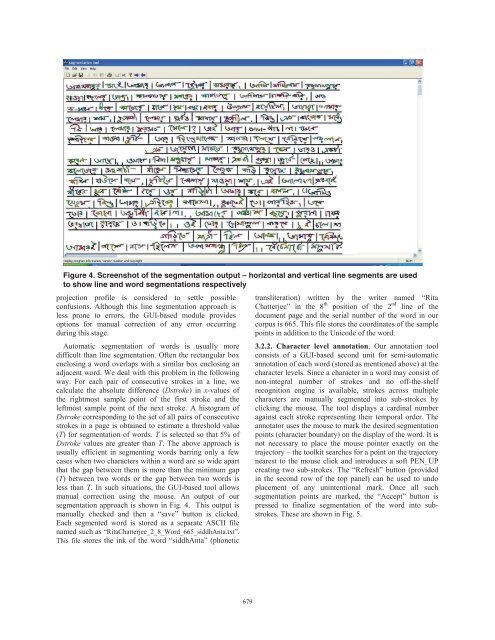A Semi-automatic Annotation Scheme for Bangla Online ... - icfhr-2012
A Semi-automatic Annotation Scheme for Bangla Online ... - icfhr-2012
A Semi-automatic Annotation Scheme for Bangla Online ... - icfhr-2012
You also want an ePaper? Increase the reach of your titles
YUMPU automatically turns print PDFs into web optimized ePapers that Google loves.
Figure 4. Screenshot of the segmentation output – horizontal and vertical line segments are used<br />
to show line and word segmentations respectively<br />
projection profile is considered to settle possible<br />
confusions. Although this line segmentation approach is<br />
less prone to errors, the GUI-based module provides<br />
options <strong>for</strong> manual correction of any error occurring<br />
during this stage.<br />
Automatic segmentation of words is usually more<br />
difficult than line segmentation. Often the rectangular box<br />
enclosing a word overlaps with a similar box enclosing an<br />
adjacent word. We deal with this problem in the following<br />
way. For each pair of consecutive strokes in a line, we<br />
calculate the absolute difference (Dstroke) in x-values of<br />
the rightmost sample point of the first stroke and the<br />
leftmost sample point of the next stroke. A histogram of<br />
Dstroke corresponding to the set of all pairs of consecutive<br />
strokes in a page is obtained to estimate a threshold value<br />
(T) <strong>for</strong> segmentation of words. T is selected so that 5% of<br />
Dstroke values are greater than T. The above approach is<br />
usually efficient in segmenting words barring only a few<br />
cases when two characters within a word are so wide apart<br />
that the gap between them is more than the minimum gap<br />
(T) between two words or the gap between two words is<br />
less than T. In such situations, the GUI-based tool allows<br />
manual correction using the mouse. An output of our<br />
segmentation approach is shown in Fig. 4. This output is<br />
manually checked and then a “save” button is clicked.<br />
Each segmented word is stored as a separate ASCII file<br />
named such as “RitaChatterjee_2_8_Word_665_siddhAnta.txt”.<br />
This file stores the ink of the word “siddhAnta” (phonetic<br />
679<br />
transliteration) written by the writer named “Rita<br />
Chatterjee” in the 8 th position of the 2 nd line of the<br />
document page and the serial number of the word in our<br />
corpus is 665. This file stores the coordinates of the sample<br />
points in addition to the Unicode of the word.<br />
3.2.2. Character level annotation. Our annotation tool<br />
consists of a GUI-based second unit <strong>for</strong> semi-<strong>automatic</strong><br />
annotation of each word (stored as mentioned above) at the<br />
character levels. Since a character in a word may consist of<br />
non-integral number of strokes and no off-the-shelf<br />
recognition engine is available, strokes across multiple<br />
characters are manually segmented into sub-strokes by<br />
clicking the mouse. The tool displays a cardinal number<br />
against each stroke representing their temporal order. The<br />
annotator uses the mouse to mark the desired segmentation<br />
points (character boundary) on the display of the word. It is<br />
not necessary to place the mouse pointer exactly on the<br />
trajectory – the toolkit searches <strong>for</strong> a point on the trajectory<br />
nearest to the mouse click and introduces a soft PEN_UP<br />
creating two sub-strokes. The “Refresh” button (provided<br />
in the second row of the top panel) can be used to undo<br />
placement of any unintentional mark. Once all such<br />
segmentation points are marked, the “Accept” button is<br />
pressed to finalize segmentation of the word into substrokes.<br />
These are shown in Fig. 5.


